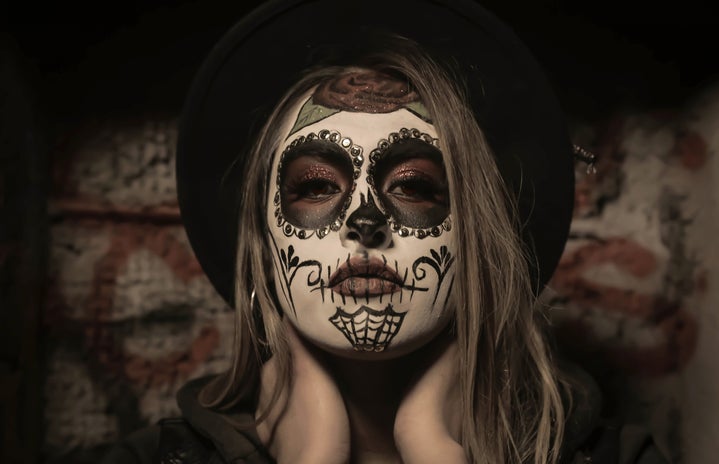Growing up, one of my favorite traditions was Dia de Los Muertos. The ofrendas, pan de Muerto, and going to visit my loved ones at the cemetery are all so important to me. Dia de Los Muertos is a Mexican holiday celebrated to honor dead relatives and their memory. It takes place over a couple of days, starting on November First and ending on November Second. The first day is for honoring little ones who have passed and is often referred to as “El dia de Los Inocentes.” (translates to “Day of the innocent,” but is often referred to as All Saints Day here in the US) The day following is to honor all who were not children, and is most commonly referred to as Dia de Los Muertos. (translates to “Day of the Dead,” but is often referred to as All Souls Day here in the US.) For many, the celebration also starts on October 31st, where the living and the dead come together to celebrate as one.
To celebrate, families do many things. These traditions include setting up ofrendas, which are beautiful altars with pictures of their loved ones, yummy foods, oranges, and other elements such as water, salt, candles, and flowers which all hold meanings that honor their memory. The most common flowers are marigolds, as they are said to help dead loved ones find their way to their family. They also have sugar skulls and papel picado, which is tissue paper cut up in beautiful ways.
On the days of, families head to cemeteries to clean up graves and to spend the holiday with those who they are honoring. It is believed that during this time the spirit of your loved ones return, and for one day a year you can spend it with those who are no longer here.
Dia de Los Muertos dates back to before the Spanish arrived in Mexico. Because of this, it is celebrated differently all throughout Mexico. Despite the way it looks, it is a time in which families all around honor loved ones, and come together as one. There are many ways in which this lovely holiday is celebrated and below are a few you can also participate in.
- Make Papel Picado!
-
This bright and simple decoration makes every ofrenda look so colorful and pretty on Dia de Los Muertos. It is also hung on the streets and is usually found everywhere during this time. It is quite easy to make and a very fun craft to make with friends.
Here is an English tutorial, and here’s one in Spanish. The English tutorial is a simple method used for many holidays in Mexico, and the one in Spanish has designs specifically for Dia de Los Muertos.
- Watch Coco!
-
This is one of the best Disney films EVER made. The music, animation, and characters are all out of this world. This movie also does an amazing job of showing Dia de Los Muertos and what it is. It is such a fun way to learn more about the holiday, and is probably the easiest way to celebrate on this list!
- Paint your Mask!
-
This year, we have introduced masks to many of our celebrations, and adding some marigolds or the traditional sugar skull of Dia de Los Muertos to yours might be a fun and simple way to honor the holiday. Making a sugar skull is also not a bad idea!
- Make Pan de Muerto!
-
Pan de Muerto (directly translated to “Bread of the Dead,”) is one of the yummiest Dia de Los Muertos treats. I’ve left the best way to celebrate for last, but beware. This is a time-consuming activity. However, Pan de Muerto is a delicious treat and is served best with hot chocolate, and a great snack or dessert to share with friends. It is soft, light, and airy, coated in crunchy sugar that all melts together in your mouth perfectly. Though it is not a quick process, the end result is worth it every time.
Recipe for Pan de Muerto:
Four cups of all-purpose flour.
¾ of a cup of sugar.
½ cup of warm milk.
One and ½ packets of active dry yeast.
Three eggs, and three additional egg yolks.
⅔ cups of butter, cubed.
2-3 tablespoons of orange blossom water. (If you cannot find it, you can sub with both orange juice or water.)
The zest of two oranges.
¾ of a teaspoon of salt.
How to Prepare:
Begin by mixing about a cup of your flour, two tablespoons of your sugar with the yeast and warm milk. You’ll then cover this mixture with cling wrap and let sit in a warm place for 20 minutes so the yeast can bloom. Next, zest your orange. Set that aside.
Now for the fun part. On a clean, dry counter, we are going to pour the flour and create a small dent in the center. Pour your yeast mixture into the dent you have created. Add your eggs and yolks into the yeast one at a time, without touching the flour too much. After your eggs are incorporated, begin to mix the yeast and the flour. Once your flour and yeast are mixed, go ahead and mix with your sugar and salt. When they are incorporated into one another, we are going to gradually add our butter.
At this point, your mixture should be sticky. It is okay! At this point, we are going to add our zest and orange blossom water. Then, we are going to simultaneously do an arm workout, because we are going to knead until the dough is no longer sticking to your counter. As long as this takes, DO NOT ADD MORE FLOUR. This will ruin your Pan de Muerto. Just be patient, because it is so worth it. If you find that you’ve been mixing for over 15 minutes and your dough is still sticky, you can add an extra fourth cup of flour or so. You’ll know your dough is ready if you stretch out like you do slime, and it doesn’t rip.
We are now going to grease a bowl and let the dough in a warm place so it can rise. It should triple in size. This process ranges between one hour and two. In Colorado, it usually takes two because it is cold. Roll out your dough onto the counter and cut up into 3-4 pieces. Shape into round circles and place on a lined baking tray or pan. Set to rise for another hour. We then bake our bread at a 350-degree oven for 20-25 minutes, or until golden brown.
After your bread has cooled on a baking sheet completely, we are going to brush with melted butter. Finally, sprinkle with sugar to evenly coat your bread and ta-da! You have successfully made Pan de Muerto. All that’s left now is to enjoy.
It is important to note that Dia de Los Muertos is not related to Halloween. It is its own holiday, with beautiful, distinct traditions and culture. Its purpose is to honor and celebrate loved ones who have passed and does not celebrate death itself. It is also important to note when celebrating this time of year that someone’s culture is not a costume. Dia de Los Muertos is such a wonderful holiday, with many possibilities to celebrate. Let us know which one you try!



